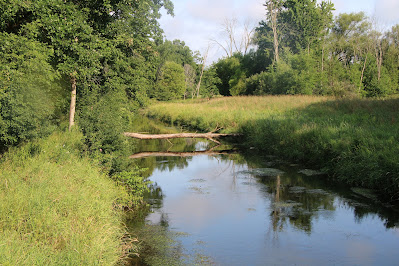The early morning sky is partly sunny with temperatures in the low 70’s, as I stand on the edge of a field of tall corn to watch the water of Honeyoye Creek flow slowly southeastward toward its confluence with the Pine River, ¾-mile downstream. Moving through tall, wet vegetation, I notice a Goldenrod plant with an unusual growth of leaves on top of the main stalk. Called a "bunch gall," "rosette gall," or "flower gall," it occurs when a minuscule midge fly lays its egg in a leaf bud. After the grub hatches, its presence somehow keeps the stem from growing and elongating, resulting in a tight, flower-like cluster of leaves. Passing through a shady woodland, I first come upon an Indian Pipe plant whose common name comes from its supposed resemblance, when in flower, to a peace pipe. Other common names, include Corpse Plant and Ghost Flower. Next, I come upon a 500 lb. Pudding Stone, a type of sedimentary rock known as a conglomerate that metamorphosed into a rock of white quartzite, pebbles of jasper and dark-colored inclusions. These stones first got their name from their similarity to European settlers’ favorite fruit pudding dishes. Referring to a map while exploring this watercourse and the surrounding floodplain, it becomes clear that, years ago, the creek channel was straightened out, cutting off the old meandering creek bed that remains as a wetland. Along this old creek bed, I hear the loud shriek of a Green Heron and watch it land on a far-off branch. Normally seen with a hunched, short-neck profile (stock photo), I’m surprised to see this bird with an extended neck. These birds have specialized vertebrae that allow them to do this to look bigger, scare off predators and also hunt fish. Working my way onto Riverview Rd., I pause on the bridge to observe the creek water flow gently through a lush riparian landscape. Exploring the wet grass along the bank, I spot a perching, Blue-tipped Dancer Damselfly along with a female Halloween Pennant dragonfly. The reason for the “pennant” in their name is that they resemble tiny flags streaming off the pond grasses while the reason for the “Halloween” in their name is that the orange and black coloring of their wing bands, especially of the male (stock photo), is reminiscent of the shades of this spooky holiday. Suddenly, a gust of wind rustles the wet leaves overhead causing water droplets to fall on the smooth surface of the creek, producing a series of concentric ripples. These waves are formed due to an equilibrium between the force of gravity and the surface tension of the water.
Past rushes and reeds
Rocks and redwings
Run creek, run
Under limbs and logs
Leafage and lichens
Run creek, run
Over sand and silt
Stumps and stones
Run creek, run
Through fields and fens
Floods and fog
Honeyoye, run
D. DeGraaf

No comments:
Post a Comment